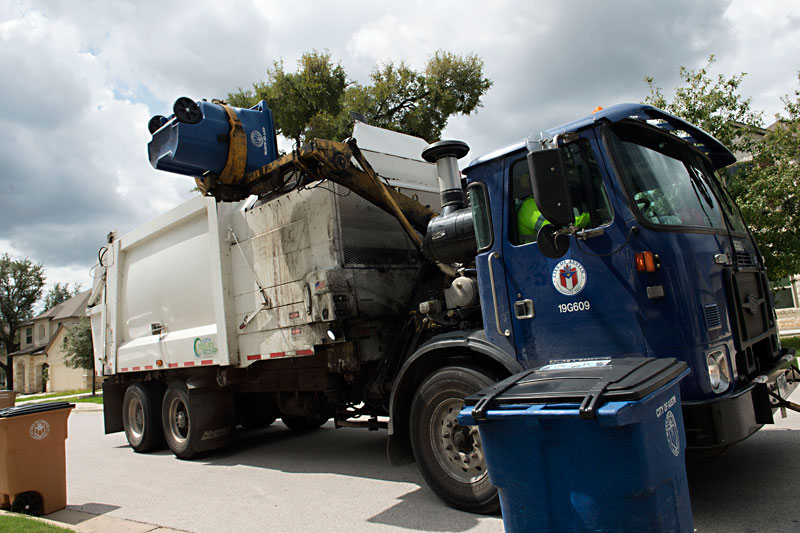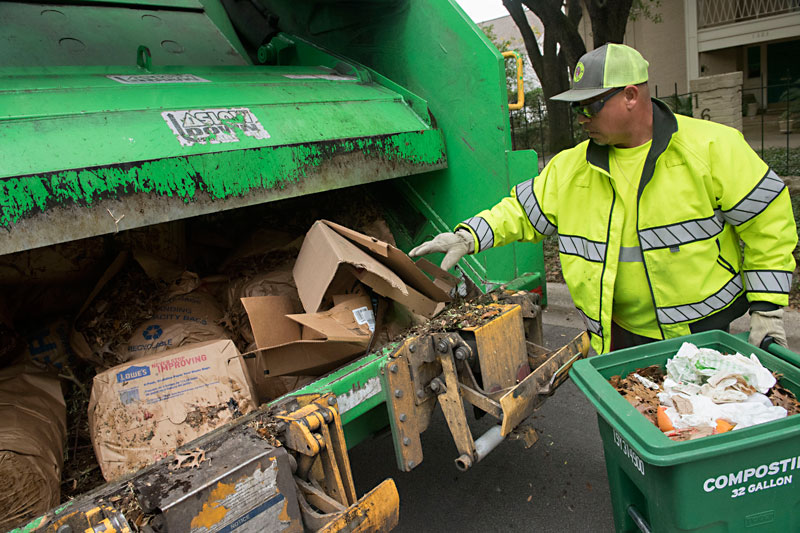Has Austin Resource Recovery Found a Solution to Its Chronic A/C Problem?
Taking the heat off local garbage collection trucks
By Austin Sanders, Fri., Dec. 9, 2022
When the air conditioning breaks down in a passenger vehicle, it's just an unpleasant inconvenience. But in garbage collection trucks, like the ones operated by Austin Resource Recovery crews, it's a different story. Operators constantly stop and go from one curbside customer to the next, preventing trucks from building airflow to cool drivers, who sit inside a tightly confined cab, directly above the truck's engine compartment. The heat and close quarters can feel suffocating even with A/C – which, at one point this summer, 1 in 5 ARR trucks did not have.
"It's like hell in there," Roy Rivera, who worked at ARR for eight years before moving to the private waste collection industry, told us. "You've got sweat running down your face, burning your eyes, which is a safety hazard because the trucks are big, heavy, and can be dangerous if you're not fully alert."
Rivera's decision to quit ARR was not made lightly. He hoped to work his way up the department's ranks, but felt stymied by management. With Austin's rising cost of living and what he viewed as insufficient concern for employee safety and a culture of retaliation against those who complained, Rivera pulled the trigger. Not having to work through another long Texas summer with trucks that may not have working A/C is a bonus.
Temperatures have cooled down over the past two months, which makes now the time to do something about heat stress on ARR operators. With global climate change creating ever more extreme weather – including extreme heat – drivers hope ARR management will have a sustainable solution for cooling the collection fleet before the hot days return.
An Urgent Issue Now
Though garbage collection is considered a dangerous occupation (the Bureau of Labor Statistics found waste collection had the sixth-highest rate of fatal injuries in the United States), heat is not yet one of its major hazards. According to ARR, since 2017, the number of heat-related injuries among field employees has remained low compared to other injuries. In 2017, six people experienced a heat-related injury out of 83 incidents; by Aug. 30, 2022, two people had experienced a heat-related injury this year, out of 43 incidents.
But if the summer of 2022 is a new brutal baseline, working outdoors has become much less safe. The National Weather Service defines temps between 93.3 and 101.2 degrees to be in the "Extreme Caution" zone, which can cause "heat stroke, heat cramps, or heat exhaustion." From June 1 to Aug. 31, the average temperature in Austin was 88.8 degrees – the second-hottest year on record (2011 remains the hottest, with an average temperature of 89.5 degrees). There were 68 days with 100-degree heat in 2022, the third most ever. Climatologists expect summers to just get hotter.
Michelle Tigchelaar, a research scientist at the Stanford Center for Ocean Solutions, studies the impacts rising temperatures have on outdoor workers. In 2020, Tigchelaar collaborated with HuffPost on a story examining the risks United States Postal Service workers face amid global warming. Tigchelaar analyzed factors of various working conditions of the job to determine dangers presented to workers should global temperatures increase by 3.6 and 7.2 degrees, as climate scientists predict is likely.
Tigchelaar told us that based on our description of working conditions ARR employees may face – trucks without functioning A/C, access to shade, and employer-mandated breaks, for example – her analysis is applicable. "With heat-related illness, there's environmental heat, what people wear, how actively they move around, how much heat their bodies generate, and what kind of breaks they can take," Tigchelaar said. "That combination determines what the safe working threshold is for working outdoors in the heat."
This summer, Travis County experienced a total of two "unsafe working days" as defined by Tigchelaar's research (heat index above 94.5 degrees, employees wearing single-layer clothing engaging in moderate work intensity, with 10% of a shift allocated for breaks in the shade). With 3.6 or 7.2 degrees of warming, the number of unsafe days would jump to 64 or 120 days, respectively.
ARR employees, along with the union that represents them, AFSCME Local 1624, have asked management to find a sustainable A/C solution for years. Several ARR employees told us that broken A/C units continued to be a problem this summer. Rodney Sutton was so frustrated by management's inadequate response that he took the unusual step of complaining publicly at a City Council meeting.
"Half of our trucks don't have [functioning] A/C and it's 120 or 130 degrees in the trucks sometimes," Sutton, who joined ARR in 2020, told Council. (ARR said they do not have temperature readings from inside their trucks.) Two months later, he returned to City Hall during one of Council's budget adoption meetings to again tell CMs that spotty A/C operation was a problem for ARR employees.
We’re Working on It
In between Sutton's two trips to City Hall, Council Member Kathie Tovo asked ARR Director Ken Snipes to provide an update. In a July 28 memo, Snipes wrote, "Due to both high service demand and the operational nature of these severe duty vehicles, especially during extreme weather events, we tend to see an increase in these types of repairs." Snipes said ARR was exploring a "redundant air conditioning system" that would be more reliable and easier to repair. (The memo also clarified that 43 of the department's 210 collection trucks had inoperable A/C at that point in the summer.)
ARR explained to the Chronicle how the new A/C systems would function, as well as other steps the department has taken to protect workers, including four 15-minute mandatory breaks per shift that can be taken inside of an idling truck, assuming the A/C is operable. Crews can use Austin Public Library locations and Austin Fire stations as cooling stations. (With cooler temperatures, ARR has returned to its normal schedule, requiring two 15-minute breaks per shift.) The department also pushed back collection start time from 6 to 5:30am, so operators would spend less time working during peak heat.
Other changes include changing the truck base paint color to white, which can keep vehicles cooler. Following the unusually high number of heat-related injuries during the summer of 2017, which ARR Safety Supervisor Bill Huck attributed to humidity levels in excess of 80% after rain brought on by Hurricane Harvey, ARR invested in uniforms made out of wicking material, which helps keep workers cool.
Mandatory breaks are good policy, but ARR employees say they are not always taken because of pressure from management to complete collection routes on time. Trash collection is an essential city service that many residents take for granted. If a customer calls 311 to complain their house was skipped, ARR typically sends out a truck to collect the trash, reflecting the high priority the city places on ensuring collection runs smoothly.
ARR Assistant Director Tammie Williamson said operators are instructed to take the mandatory breaks, even though finishing routes on time is a top priority. But ARR does not track if employees take the breaks, so they can't say if the policy is effective. Safety supervisors conduct field audits, but monitoring individual operators for mandatory break compliance is impractical. "We value our employees' health and safety as much as we do our customers' satisfaction," Williamson said. "I'd be hard pressed to tell any of my employees to stick it out and finish a route rather than take a break."
But some ARR employees feel management prioritizes finishing routes quickly over worker safety. Field operators are required by law to complete a safety checklist at the start and end of every shift, but employees told us that sometimes supervisors encouraged them to take out trucks operators felt were unsafe – with weak brakes, broken dashboard gauges, and electrical problems.
Employees say the threat of retaliation discourages them from complaining formally. "It feels like the chain of command is against us," an operator who has worked at ARR for more than a decade told us (we're not publishing the operator's name because they fear retaliation). "Complain too much and you'll get the shit detail."
Rivera, the ARR employee who recently quit, agreed. "Managers have an old-school approach. They want to put fear into you instead of motivating you," Rivera told us. "It's a militaristic culture. You get the job done with the equipment you've got, no matter what."
Snipes refuted this characterization of the department he leads and denies that employees are ever forced to take out unsafe trucks. "At no time will we ever ask anybody to take a vehicle out that they feel is unsafe," he said. "It's just not something we believe in. If they feel a vehicle is unsafe, they should immediately elevate that concern to the fleet coordinator."
Finding a Good Solution
Beyond any workplace culture issues, employees eagerly await reliably functioning A/C across ARR's fleet. The stop-and-go nature of garbage collection puts immense strain on vehicles, which accelerates the rate at which parts break down. Under current specifications, the A/C unit sits right next to the truck's motor, which requires it to work hard to cool down the truck's cab and leads to more frequent breakdowns of the A/C.
Door-to-door garbage collection will always be stop-and-go, but Snipes hopes his staff has found a long-term solution to the second problem: moving the A/C unit to the truck's roof so it's not right next to the hot engine. ARR experimented first with just mounting the A/C unit on the top of trucks, while leaving the condenser in the engine compartment. But the condensers still broke down frequently. Then, ARR ordered a fully top-mounted system – the A/C unit, condenser, and a battery pack all sit on top of the roof so they're completely separated from the engine.
The department says early testing shows this setup is more reliable and creates redundancy: The older A/C unit still functions, but if it breaks down, the top-mounted system can take over. The newer A/C units can be repaired by city Fleet Mobility Services after being unmounted, so a truck doesn't have to be pulled from the field; trucks awaiting A/C repair sometimes sit in the Fleet Services garage for weeks waiting on parts that are back-ordered.
When parts arrive, Fleet mechanics sometimes struggle to turn repairs around quickly, due to the "high demand and severe service duty" of refuse trucks, a city spokesperson said. Fleet Services is also experiencing a 22% vacancy rate, requiring a "multi solution repair strategy that includes weekend work, overtime, and the use of outside vendor resources," according to the spokesperson. Fleet Services estimates that the new A/C systems take about eight hours to repair.
ARR's plan is to ensure that new collection trucks, which are built to order, are equipped with the newly designed A/C system. (On average, garbage trucks last 10-15 years; the average age of the ARR fleet is about 4.3 years.) ARR will retrofit trucks in the fleet manufactured between 2015 and 2019 to use the new units (costing about $1,820 each, or $93,000 total). As of Nov. 29, ARR had 63 trucks with the new A/C setup operating in the field.
It's unclear whether ARR's A/C solution is sustainable if temperatures continue to rise. But Krissy O'Brien, an organizer at AFSCME who has followed the A/C issue closely, is cautiously optimistic. "We have to keep the pressure on," she said. "We want to make sure we don't go through another summer with people calling us because they're afraid of heat exhaustion."
The ARR operators who survived one of the hottest summers fear that failure to provide a real solution will have an outcome more dire than heat exhaustion. "We don't want to have to name a building after somebody else," an anonymous operator told us, referring to the Kenneth Gardner Service Center where ARR trucks are repaired. The facility was named after Gardner, a beloved employee of 20 years who died in an on-the-job accident in 2006. "We just hope someone doesn't have to die of heat stroke before management cares enough to actually fix the problem."
Dreaming of a Green Christmas
While we're on the topic of trash, you may be planning to use last week's cover to wrap presents selected from our gift guides. When you're done with a wrapping session, and are left with a pile of shipping packaging and wrapping paper the size of Mount Crumpit, Austin Resource Recovery workers will be there to help. Here's a quick reminder of what to do with your bushels of trash.
Recycle. Cardboard, plain wrapping paper, and the tape left on your paper can all go in your blue recycling cart. If it doesn't all fit, no sweat – extra recycling can go in a cardboard box or a reusable container next to your cart. If you have excess cardboard, you should cut or fold it into 2-by-2-foot piles, tie them into manageable bundles with string or twine, and set those down next to your recycling cart. Extra recyclables won't cost you anything, but if your blue cart is regularly overflowing, you can call 512/494-9400 to request an additional one, free of charge.
Reuse. Ribbons and bows aren't accepted in your recycling cart, but you can hold onto them for future gifting. Wrapping paper with glitter or foil is also not recyclable. Speaking of reusable wrapping, consider wrapping your gifts with reusable materials such as newspaper (oh, like this one!) or reusable gift bags and boxes.
Drop-Off. Stretchy, flexible materials such as bubble wrap and plastic wrap are not accepted in your cart, and neither is Styrofoam, but you can take these to the Recycle & Reuse Drop-Off Center at 2514 Business Center Dr., just off Ben White, east of I-35. Just make sure the materials are clean and dry before dropping them off. – Maggie Q. Thompson
* Editor's note Thursday, Dec. 9, 3:10pm: This story has been updated. The story incorrectly stated that installing A/C would cost $93,000 per truck; the actual cost is $1,820 each plus $5,000 in shipping, for a total of $93,000. We regret our error.
Got something to say on the subject? Send a letter to the editor.











